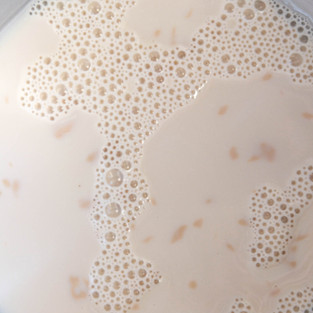Brioche: The Fluffiest Cloud-like Bread Bound to Conquer your...Mouth?
Making bread was something I always dreamed of doing. It seemed like a complicated and arduous process before I even had the courage to try it out. After many attempts, I realized making bread is something extremely personal. You have to get to know your flours and how they interact with the other ingredients, how different types of yeast act and which one you like the best, your kitchen and its varying temperatures and personalities, your oven’s mood swings, how the dough feels at its various stages, you have to discover different ways of doing the same thing and which one works best for your environment, and so many other things that make bread making an intimate process. I’m not going to lie; it is not like making cookies or whipping up a one bowl cake. It is more complex and intricate than that, but that is exactly what makes it such beautiful form of art.

Cali, Colombia. Mid-late 2000's
My mom is a firm believer in the benefits of a healthy diet. Growing up, I was not allowed to have junk food. To this day still I remind her that, while all my friends would be eating potato chips and Nutella sandwiches during snack time at school, I would be peeling away a mandarin that was a few days past its optimal point, or eating an apple that had been squished inside my lunchbox, like if she had somehow robbed me of my childhood for not indulging my infantile desires of highly processed food. One of the things I will never forget, is how she would firmly refuse to buy white bread, let alone those at the supermarket. “They are full of chemicals and carcinogens! Why do you think they keep outside the fridge for so long?!” she would say as she dragged me away to the produce section while I still had my eyes fixed on white sliced bread. Instead, she would buy all of our bread from a local bakery that used none of those so-called chemicals and carcinogens and would not last more than two days outside of the fridge. It drove me nuts.
However, thanks to her militaristic approach to feeding her children as healthy as she could, I grew up being extremely curious and conscious about the food I eat. Beyond just trying to maintain a hearty diet, I am more interested in the making of food and everything behind it. Of course, I created this website wholly dedicated to baked goods, which includes sugars, white flours, chocolate, butter, butter, and more butter, but the whole point of it is to appreciate what we make, to understand how things work, and to enjoy not only doing but knowing and learning. In short, my mom did pass down to me a slight obsession about organic food and quality products, I mean, before the quarantine I would go every day to the supermarket just to look around, and I did spend 50 euros for 500 g of take-home Cotoletta alla Milanese at Milan’s fanciest deli, but nothing can keep me away from a buttery, fluffy, tender, cloud-like piece of bread.
After many months of baking brioche at least twice a week, countless tastings and critiques by my boyfriend, and a couple of exasperation tears, I was finally able to develop and perfect my own brioche recipe which you will find below. First, however, I have compiled and redacted to the best of my ability an informative section where I will attempt to pass down my knowledge to you, so you can, too, make brioche at home.
Before You Even Start
Flour Selection
After testing this recipe for what seemed like an infinite amount of times –something my boyfriend can attest to– I have come to the conclusion that the best flour to use for brioche is bread flour, which is oftentimes referred to as “strong flour”, “high protein flour”, or “Manitoba flour”. Unlike some other types of wheat flour, bread flour has a very high protein content, typically of 13-15%. This protein, also known as gluten, is our friend and ally when making bread, and are responsible for all the good characteristics of bread; they are what give it its signature chewiness, beautiful rise, and maintain its dazzling structure. So, even though gluten may have become a dirty word, it is actually a marvelous and key component in the bread making process. Therefore, for this brioche to achieve that splendid rise and cloud-like texture we persistently hope for, we must use bread flour.
I know what you're thinking, and the answer is yes. Yes, you can use AP flour for this, but your brioche will most likely not have the ideal crumb. That is because AP flour typically has a protein level of around 10%, which means it has a low gluten content. However, if you cannot find high protein flour, it’s not the end of the world, you can make this bread regardless and it will still turn out delicious.
If you can get your hands on bread flour, do it - don't be lazy. In most countries, you can find it in grocery stores, or better yet, you can order it online. Here are some options if you want to order online:
In the US, King Arthur Flour has a decent bread flour, although it has a slightly lower protein than I would like (12.7%), but they also have a high gluten flour with 14.2%. You can also try Bob's Red Mill bread flour which has 13.8%. Central Milling also has a decent bread flour with 13.5% of protein.
In the UK, you can get your hands on Dove's Farm bread flour which has 12.6% protein, also on the lower side.
In Italy, Molino Pasini has an amazing 15% protein bread flour, and Mulino Marino has an even stronger one with 16% protein (their farina tipo "0" Manitoba BIO). You can also find an astounding variety of flours in supermarkets, including good quality bread flours.
In Colombia, unfortunately, I have never come across bread flour in grocery stores, let alone a mill that sells online. However, you can certainly find them in specialty baking stores, or you can ask your local bakery where they get it from (they might even be willing to sell you some).
If you find yourself in the supermarket but can't figure out if the flour you're looking at will be good for this recipe, just look at the nutrition table. Most display nutritional value by a serving size of 100 g, therefore, if the protein content is 14g, then the protein percentage is 14%. If the nutritional values are based on another serving size amount, just divide the protein content by the serving size and multiply by 100. Remember, for optimal results, protein must be between 13-15%. If 12% is the only thing you can find, then that will have to do.
Yeast
There are three main types of yeast: instant yeast, active dry yeast, and fresh yeast. You can use all of them interchangeably, but you will need to adjust quantities.
To convert from fresh to active dry
Multiply the amount of fresh yeast called for in the recipe by 0.4. For example, 25 g (of fresh yeast) x 0.4 = 10 g (of active dry yeast)
To convert from active dry to fresh
Divide the amount of active dry yeast called for in the recipe by 0.4. For example, 10 g (of active dry yeast) / 0.4 = 25 g (of fresh yeast)
To convert from fresh to instant
Multiply the amount of fresh yeast called for in the recipe by 0.33. For example, 25 g (of fresh yeast) x 0.33 = 8.25 g* (of active instant yeast)
To convert from instant to fresh
Divide the amount of instant yeast called for in the recipe by 0.33. For example, 8.25 g (of instant yeast) / 0.33 = 25 g (of fresh yeast)
To convert from active dry to instant
Divide the amount of active dry yeast called for in the recipe by 1.25. For example 10 g (of active dry yeast) / 1.25 = 8 g (of instant yeast)
To convert from instant to active dry
Multiply the amount of instant yeast called for in the recipe by 1.25. For example 8 g (of instant yeast) x 1.25 = 10 g (of active dry yeast)
*keep your amounts to 0 decimal places when actually measuring them in your scale. Below .5 round down, above .5 round up. Most scales for home baking weigh to 0 decimals.
I have only ever used active dry yeast and fresh yeast, and I do have a preference for fresh yeast. I find the flavor development milder. The only times I have over-fermented my dough has been while using active dry yeast, so if using this type, make sure you are paying close attention to the development of your dough during its rises. I have also adjusted the sugar quantity in this recipe to reduce the chance of over-fermentation. I also think fresh yeast is more enjoyable to work with, as you don't have to completely dissolve it in your liquids (or at all for that matter) and you don't have to activate it, like you would have to if using active dry.
Milk Temperature
The temperature of the milk is extremely important in this recipe. You want to have lukewarm milk which is around 25° C / 77° F. If you don't have a thermometer, don't worry, I never use it for this step. However, you want to make sure your milk is warm to the touch, but not so warm that you can't keep your finger in for more than 5 seconds. This is important because you want to be able to activate the active dry yeast (if using it) while still being able to dissolve it WITHOUT killing it. I think it goes without saying that if you kill your yeast, there will be no bread on your table. If you are using fresh yeast, it is also important to have lukewarm milk, as it will wake up the yeast from hibernating in your fridge and will put it to work. I also like to be able to dissolve it so it better incorporates with the flour in making the poolish, but technically fresh yeast does not need to be dissolved in liquids to work.
Eggs
This recipe has more eggs than others I saw when developing it. The eggs not only bring in fat and protein but also moisture. Given the high amounts of eggs, this brioche dough is extremely wet, which will in turn yield a fluffy and light brioche. I always use free range organic eggs which are, the majority of times, of medium size. If you use smaller eggs you will not be adding the right amount of fat, protein, and most importantly, moisture to the dough. Contrarily, if you use large or extra large eggs, your dough will be almost like water and impossible to work with. As a rule of thumb, medium eggs weigh 50 g, so make sure you double check before adding them to the dough.
Butter
This bread is essentially butter, which is why its so irresistibly delicious. It is also why you have to make sure you get the highest quality butter you can find. In Europe most butters have 82-83% fat content. If you can find butter with this level of fat, your brioche will be exquisite. To find this information, refer to the nutritional table and divide the amount of butter by the serving size.
Windowpane Test
The windowpane test is used to asses if the dough has developed enough gluten. Take a small piece of dough and stretch it between your fingers. If you can stretch it until the point where it’s a very thin film and you can see light through it, your dough has successfully developed a solid gluten structure. If it tears as you are stretching it, this means the gluten is too weak and has not fully developed, and you need to keep kneading your dough. This test will come in handy especially if making by hand.

Degassing the Dough
Degassing the dough refers to when it has risen to double its size, and you either move it around or apply pressure to deflate the dough and force the gasses inside produced by the yeast to escape. The dough will, in turn, reduce in volume. This creates a new environment for the yeast to keep reproducing and keep forming gasses. I use two methods to degas my dough. Which one I choose depends on the state of the dough.
If the dough is still very liquid and sticky, which it is after its first rise at room temperature, I run a bench scraper along the sides of the bowl, and as I take the bench scraper out, I pull the dough upwards forcing the gasses out.
If the dough is stiff, typically after rising in the fridge, I give the dough a punch in the middle, pressing down as it deflates.
Proofing the Shaped Dough and The Poke Test
After you have shaped your dough, there is a final step before it goes into the oven called proofing. What is happening here is essentially what happens when the dough rests and rises in other parts of the bread making process: the yeast is developing gasses that create air pockets throughout the dough allowing to rise. When you over proof your dough, the air bubbles inside it have become too big and the gluten structure inside the bread is weakened. Therefore, the dough will rise in the oven but will quickly collapse once taken out. When you underproof your dough, it has not yet formed enough air pockets and will result in a very tight crumb when baked, which is not what you’re looking for when making bread, especially brioche.
The Poke Test
To know if your dough has been correctly proofed, cover your finger in flour and poke the dough. If it springs back quickly leaving no indentation, it is under proofed and you need to let it rest longer. If it does not spring back at all and leaves the complete indentation of your finger, your dough has over proofed. If, when you poke it with your finger, it springs back slowly leaving a small indentation, it is perfectly proofed and ready to be egg washed and taken into the oven.
If your dough has over proofed, don’t worry, you can fix it. Just take the dough out of the tin (if using one) and knead it together for a couple of seconds to degas it. Shape it again, and proof.
Tips for Making by Hand
I do not want to deprive anyone from being able to indulge in the delicacy that is home made brioche, so I will not say you can only do this using a stand mixer. However, if you are part of that fearless group of people that will attempt to do this brioche by hand, hats off to you. This is an extremely enriched and wet dough, which will make it very tricky to work with and correctly developing the gluten will be a long a tedious process. However, do not let this stop you from indulging in this buttery fluffy delicacy.
Tip 1. Reduce the eggs by one. This will make the dough less wet and sticky which means it will be easier to work with. You will lose a bit of the richness of the dough, but nothing to be too worried about.
Tip 2. It is already specified in the recipe, but make sure your butter is 100% at room temperature and previously cut into cubes. This will make it soft in texture and very malleable, which will allow you to incorporate it into your dough.
TIP 3. When you add the rest of the ingredients to the poolish, combine with a wooden spoon to incorporate. Once it becomes a thicker dough, invert it from the bowl into a work surface WITHOUT flour, and prepare to start kneading.
TIP 4. Kneading by hand requires a specific set of movements.
STEP 1. With your dough in front you on a work surface, place the lower part of your hand in the lower half of the dough and push away from you.
STEP 2. Gather the dough back in the middle of the work surface and repeat the movement in STEP 1.
STEP 3. Rotate your dough after every couple of kneads to make sure you are working it evenly throughout.
TIP 5. Once the dough looks homogenous and smooth, you can start incorporating the butter, a couple of cubes at the time. Add them in the center of the dough after you have pushed the dough away from you with the lower part of your hand. Then bring the dough back together and continue kneading. After the butter you added has been fully incorporated into the dough, you can proceed to adding the next couple of cubes of butter. Repeat until all of the butter has been added and properly incorporated.
Tip 3. Be patient. Developing gluten in bread is not something that happens in the blink of an eye. You will have to knead by hand for a long time, probably 20-30 minutes, if not more. But don’t give up, you will get there. Once the dough starts looking smooth and becomes less sticky, you would have successfully built up some gluten.
TIP 6. If making this by hand seems daunting, you can always start by doing half the recipe. It will be more manageable and will still yield one whole loaf of brioche.
I have also added these tips in the method part of the recipe, so you don’t have to look back every time you need clarification.
Now that you have become an expert in all things brioche, here is the recipe.
Ingredients
Poolish
115 g bread flour
25 g of fresh yeast (or 10 g of active dry yeast)
125 g/ml of lukewarm milk
Final Dough
385 g of bread flour
6 medium eggs (preferably free range)
70 g of granulated sugar
12 g of salt
230 g of unsalted butter at room temperature cut into cubes
1 egg for egg wash
Method
STEP 1. To make the poolish, in the bowl of a stand mixer, combine lukewarm milk and yeast (if using fresh yeast, make sure you crumble it before adding it to the milk). Whisk to dissolve yeast. Add in flour and combine with a spatula until you have a wet shaggy dough. Cover with plastic wrap and let sit for 20 minutes if using fresh yeast, or 45 minutes to 1 hour if using active dry yeast. At the end of this period, your mixture should look fluffy and full of holes, and it should have a yeasty smell (especially if you're using active dry yeast).
STEP 2. Add the rest of the ingredients, except for the butter, into your poolish, in no special order, with no special procedure. With your stand mixer fitted with the dough hook attachment, mix the ingredients on medium speed until well combined. Increase speed to medium high and continue mixing until the dough starts climbing up the dough hook and pulling away from the sides of the bowl, and looks smooth and shiny with no lumps.

If doing by hand, mix the ingredients with a wooden spatula until they are fully incorporated. Then turn the dough into an UNFLOURED surface and start kneading with your hands until the dough looks smooth and shiny with no lumps. This can take up ~20 - 30 minutes.
You can also look for other signs that your dough is ready depending on what mixer you have. For me, I know the dough is ready when my mixer starts dancing aggressive salsa and I can hear the dough slapping against the sides of the bowl). I have a KitchenAid Artisan. If you have a similar mixer these signs can work for you too.

(note: This step will take varying amounts of time depending on your mixer, the temperature in your kitchen, the brand of flour you're using (different brands have different hydration), and many other factors, which is why I do not want to write a specific amount of time you should knead for. My mixer, in my kitchen, with my flour, takes 10-15 minutes).
STEP 3. With the mixer running, add the butter a coupe of cubes at the time. Allow the butter to get kneaded into the dough completely before adding the next set of cubes. Once the butter is completely incorporated, keep kneading the dough for a couple more minutes, until the it passes the window pane test. When the dough reaches that point, stop kneading.
If doing by hand, place the butter (a couple of cubes at the time) in the center of the dough after you have pushed the dough away from you with the lower part of your hand. Then bring the dough back together and continue kneading. After the butter you added has been fully incorporated into the dough, you can proceed to adding the next couple of cubes of butter. Repeat until all of the butter has been added and properly incorporated. Keep kneading until your dough passes the windowpane test. This can take ~30 minutes.
STEP 3. Transfer the dough into a slightly greased large bowl, or you can keep it in the same bowl you've ben using - that is what I do because the bowl of my kitchen aid is the largest I own. Make sure your bowl is large enough to accommodate the dough when it has doubled in size without reaching the top of the bowl. Cover in plastic wrap and let sit in a warm spot in your kitchen for about 1 hour, or until doubled in size.

(note: depending on the temperature of your kitchen, your dough will rise at a different time rate. Do not panic if your dough has not doubled its size when it hits the one hour mark. Mine sometimes takes longer depending on if the day is colder. It is always safer to go with visual queues, in this case, when the dough has doubled in size)
STEP 4. Once the dough has doubled in size, degas it by tugging around the sides of the dough with a bench scraper. Cover it back up in plastic wrap and transfer into the fridge overnight, or until you are ready to bake it. I would suggest leaving the dough in the fridge for at least 8 hours, but you can also get away with 4 hours. Time = flavor, so the more you let it rest, the better its going to taste. You might have to degas it a couple more times after you transfer it to the fridge. Just check periodically every 3 hours, and if the dough has doubled in size, degas it again.
(note: I normally do my dough at night, around 7pm, and have to degas it 1-2 times after it has been transferred into the fridge before going to sleep. For the final testing of the recipe before publishing it, I did the dough in the morning so I could take picture of the process with good light. That time, I had to degas the dough around 2-3 times throughout the day. At some point, the dough will become stiff because of the cold and it will stop rising too much, at which point you can let it be and free yourself from degassing until the next morning).
STEP 5. The next morning, take your dough out of the fridge and degas it completely. This time you can punch it down, as it will be hard and cold and it will be tricky to degas with the bench scraper method. Once degassed, you can shape the dough.

This is they way I like to do it: this recipe yields two loaves if done in a 22 cm x 11.4 cm loaf pan. I weigh the dough, divide it into two, and divide each half into 8. I make 8 small balls of dough and place them next to each other in my loaf pan, for each pan. Normally, the dough will weigh 1,200 g (1.2 kg), which means each half will weigh 600 g, and each ball 75 g.
Make sure you grease your loaf pans with butter, and if you want extra non-stick assurance you can line your tins with parchment paper, leaving a couple of cms of over hang on both sides to help remove the brioche loaf from pan once baked.
When making your balls of dough, you want to make sure you are creating tension so it can have a nice even rise in the oven. I do this by folding all the corners into the middle and then sealing them against the work surface.
STEP 6. Once the dough has been shaped, put the loaf tin inside of a large plastic bag, and close it tightly. Make sure the plastic bag is puffed up with air and it is not touching the dough. Let it proof until it has doubled in size. Sometime in the middle of this process, preheat your oven to 190° C / 375° F.
This step is extremely important to get right. If your dough is under proofed it won’t have a nice crumb and will be tight and tough, and if its over proofed it will collapse when you take it out of the oven. Refer to the “Proofing the Dough and The Poke Test” section above.
Again, the timing of this step depends on many things, mainly the temperature of your kitchen. In cold days, my dough can take up to 2h 30m to properly proof. If you live in warm weather, this might take 45 min - 1 hour or even less, so watch your dough like a hawk!
If you live in cold weather, you could place your tins in the oven ONLY with the light turned on. This will create a warm environment for your dough to proof in. However, I recommend that you just leave it in a warm spot in your kitchen and let it rise at its own pace.

STEP 7. Once your dough has properly proofed, brush your loaf with egg wash. This is the time to sprinkle anything on top should you wish to. You could do flaky salt, sesame seeds, poppy seeds, coarse sugar bits, and more. Place the loaves in the oven in the bottom position, and bake for 30 minutes. If you have a thermometer, it is really helpful to test the temperature of the dough to check for doneness. You want it to be between 85° C - 90° C.
STEP 8. Once out of the oven, let the loaves chill for five minutes inside the tins. Then take them out and transfer to a cooling rack and cool for as long as you can resist not biting into the loaves.



























I can't wait to try this recipe! Thank you for the detailed instructions! I tried a recipe for brioche bunns that was quick and tasty, but it was not brioche.